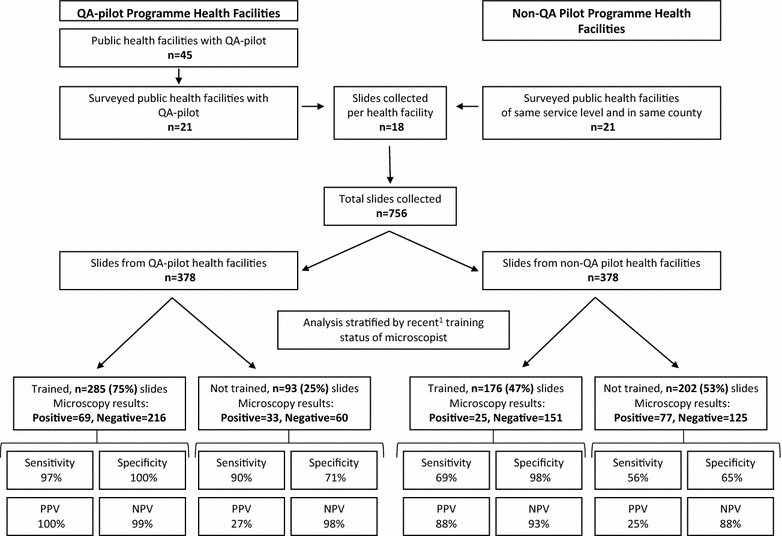Factors associated with malaria microscopy diagnostic performance following a pilot quality-assurance programme in health facilities in malaria low-transmission areas of Kenya, 2014
- PMID: 28903758
- PMCID: PMC5598012
- DOI: 10.1186/s12936-017-2018-2
Factors associated with malaria microscopy diagnostic performance following a pilot quality-assurance programme in health facilities in malaria low-transmission areas of Kenya, 2014
Abstract
Background: Malaria accounts for ~21% of outpatient visits annually in Kenya; prompt and accurate malaria diagnosis is critical to ensure proper treatment. In 2013, formal malaria microscopy refresher training for microscopists and a pilot quality-assurance (QA) programme for malaria diagnostics were independently implemented to improve malaria microscopy diagnosis in malaria low-transmission areas of Kenya. A study was conducted to identify factors associated with malaria microscopy performance in the same areas.
Methods: From March to April 2014, a cross-sectional survey was conducted in 42 public health facilities; 21 were QA-pilot facilities. In each facility, 18 malaria thick blood slides archived during January-February 2014 were selected by simple random sampling. Each malaria slide was re-examined by two expert microscopists masked to health-facility results. Expert results were used as the reference for microscopy performance measures. Logistic regression with specific random effects modelling was performed to identify factors associated with accurate malaria microscopy diagnosis.
Results: Of 756 malaria slides collected, 204 (27%) were read as positive by health-facility microscopists and 103 (14%) as positive by experts. Overall, 93% of slide results from QA-pilot facilities were concordant with expert reference compared to 77% in non-QA pilot facilities (p < 0.001). Recently trained microscopists in QA-pilot facilities performed better on microscopy performance measures with 97% sensitivity and 100% specificity compared to those in non-QA pilot facilities (69% sensitivity; 93% specificity; p < 0.01). The overall inter-reader agreement between QA-pilot facilities and experts was κ = 0.80 (95% CI 0.74-0.88) compared to κ = 0.35 (95% CI 0.24-0.46) between non-QA pilot facilities and experts (p < 0.001). In adjusted multivariable logistic regression analysis, recent microscopy refresher training (prevalence ratio [PR] = 13.8; 95% CI 4.6-41.4), ≥5 years of work experience (PR = 3.8; 95% CI 1.5-9.9), and pilot QA programme participation (PR = 4.3; 95% CI 1.0-11.0) were significantly associated with accurate malaria diagnosis.
Conclusions: Microscopists who had recently completed refresher training and worked in a QA-pilot facility performed the best overall. The QA programme and formal microscopy refresher training should be systematically implemented together to improve parasitological diagnosis of malaria by microscopy in Kenya.
Keywords: Interpretation; Kenya; Laboratory; Malaria; Microscopy; Quality assurance; Reliability; Validity.
Figures
References
-
- WHO. World Malaria Report 2014. Geneva: World Health Organization; 2014.
-
- WHO and United Nations . Kenya: WHO Statistical Profile. Geneva: World Health Organization; 2015.
-
- Division of Malaria Control . Kenya Annual Malaria Report: 2012–2013. Nairobi: Ministry of Health; 2013.
-
- WHO. Guidelines for the Treatment of Malaria. 2nd ed. Geneva: World Health Organization; 2010. - PubMed
-
- WHO. T3: Scaling up diagnostic testing, treatment and surveillance for malaria. Geneva: World Health Organization; 2012.
Publication types
MeSH terms
LinkOut - more resources
Full Text Sources
Other Literature Sources
Medical
Research Materials
Miscellaneous


